
High iron in pregnancy: what are the symptoms and what does it involve?
Controlling normal levels of iron in the blood during pregnancy is important for […]
What causes low haemoglobin during pregnancy? And what are the remedies? Let’s find out how to overcome low haemoglobin during pregnancy and what to do to maintain normal haemoglobin levels in the blood during the gestation period.
Haemoglobin is a very important protein for the human body. It is present in red blood cells (erythrocytes) and regulates the transport of molecular oxygen and carbon dioxide in the blood. At the molecular level, haemoglobin consists of four polypeptide chains that bind a haem group, a chemical complex that contains an iron ion (Fe2+).
Since iron is an essential component of the molecular structure of haemoglobin, an iron deficiency may lead in many cases to low haemoglobin values.
In general, haemoglobin values in women are between 12 and 15.5 g/dL. In pregnancy, due to the increased need for iron, the minimum value drops to 11 g/dL whilst the maximum value is 14 g/dL. With haemoglobin values close to the lower limit of the range, gynaecologists may suggest an iron-based food supplement to mitigate the deficiency of this nutrient. When the haemoglobin values fall below 11 g/dL, action must be taken to bring the values back to normal as soon as possible.
Low haemoglobin in pregnancy is often associated with iron deficiency. Indeed, 95% of anaemias in pregnancy are iron deficiency anaemias (sideropenic anaemias).
The main causes of low haemoglobin during pregnancy are:
If blood tests show a low haemoglobin condition during pregnancy, the gynaecologist will assess the most suitable approach to bring the haemoglobin blood values back to normal. Your doctor will assess the causes of the lowering of haemoglobin levels in your blood and suggest remedies to restore and maintain normal blood haemoglobin levels.
Usually, in order to prevent low haemoglobin during pregnancy, it is quite common for gynaecologists to provide a prophylaxis that includes a iron-rich diet.
A rather common problem during gestation is precisely iron deficiency. Normally, a woman of childbearing age needs 14 mg of iron per day. During pregnancy, this amount can increase to as much as 30 mg of iron daily. The iron consumed through diet helps to satisfy both the iron needs of the mother and the unborn child. Attention needs to be paid, however: not all the iron consumed through diet is absorbed in the same way by our body. Haem iron, present in animal-based foods, is more easily absorbed than non-haem iron, present in plant-based foods.
To facilitate the absorption of non-haem iron, foods rich in vitamin C, a nutrient that promotes the intestinal absorption of inorganic iron, can be included in the diet. At the same time, it is not recommended to eat foods rich in iron together with foods that can reduce or hinder the absorption of non-haem iron, such as milk and dairy products, foods containing tannins (tea and coffee), phytic acid or phytate (nuts and grains) or oxalic acid or oxalates (spinach, cabbage, chard).
When the diet is not sufficient to maintain normal iron levels during pregnancy, you can contact your doctor or pharmacist who will be able to recommend a nutritional supplement to meet your body’s increased iron requirements.
The technology that guarantees the best absorption of Iron.
Find out moreRegistered Office Via Campodavela, 1 56122 Pisa
Tel. +39 050 7846500
Fax +39 050 7846524
C.F. / P.Iva / Reg. Impr. 01679440501
Cap.Soc. € 1.123.097,70
I.V. | REA 146259
pharmanutra.it